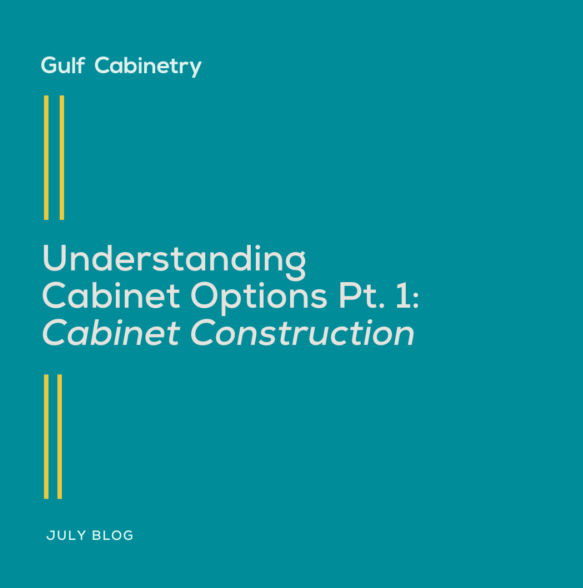Today’s endless options come with a wide variety of different kitchen cabinet construction options and styles to choose from. Not only does your cabinetry hold all of your cooking and dining supplies (plus a lot more), it covers most of the wall space in your kitchen and should essentially be considered art. Cabinet designs can be fully customized with hardware, colors, and decorative accents that match your personal home style and décor. You’re probably wondering where to start.
That’s where we come in. While it might seem like there are several options for cabinets, we’ve highlighted the general construction categories below. Once you’ve reviewed these options, you’ll be able to pin down a style that best suits your home and your budget. From there you can take the first step toward your custom cabinetry design.
In Part One of this two-part blog, we’ll discuss 3 distinct cabinet construction options. Our first consideration should be which construction type works best aesthetically and functionally in your space. It is best to be aware of some common cabinetry terms when it comes to understanding your purchase:
Cabinet doors and drawers are typically constructed with these components:
– Stiles: two vertical side pieces
– Rails: two horizontal pieces running along top and bottom
– Center: may be recessed, sometimes raised in more traditional styles
Cabinet boxes can be made of wood or high density pressed board. The cabinet frame provides stability and keeps the box square during shipping and installation. It also increases the composition strength provides a more durable and long-lasting support structure for the other components.
Frame Vs Frameless:
 Framed cabinetry is the traditional method for American manufacturers. The frame is usually 1-1.5 inches wide and is used to support the doors and hinges which are mounted to it. This is advantageous as it provides more strength and stability to the cabinet. This also allows more flexibility in the design process in creating a customized look. This will afford you more door options and decorative choices.
Framed cabinetry is the traditional method for American manufacturers. The frame is usually 1-1.5 inches wide and is used to support the doors and hinges which are mounted to it. This is advantageous as it provides more strength and stability to the cabinet. This also allows more flexibility in the design process in creating a customized look. This will afford you more door options and decorative choices.
Frameless Cabinetry is widely considered a more contemporary approach and is predominantly used in Europe although increasing in popularity in the States. The frames are eliminated, leaving just the box. Doors are attached directly to the sides of the cabinet. Larger doors and drawers are used to cover more surface area and these cabinets are also referred to as “full access” due to the absence of the frames and center stiles. If you want to maximize every inch of space and desire a more modern look, this may be your choice.
Inset vs Full or Partial Overlay:
 Inset cabinetry is when the doors of a cabinet sit flush with the frame. This is a traditional, more formal look that tends to minimize the storage space of a cabinet due to decreased access.
Inset cabinetry is when the doors of a cabinet sit flush with the frame. This is a traditional, more formal look that tends to minimize the storage space of a cabinet due to decreased access.
Full overlay is currently the most popular of these styles and showcases door and drawers that cover almost all of the cabinet face, offering a streamlined aesthetic. There is usually extra space inside of the cabinet, especially when compared to Inset products with the hinges closing into the cabinets.
Partial overlay was a favorite of American kitchens for years. The doors sit on top of the frame with a larger gap between them than full overlay. These products tend to be less expensive that either of the other two options as the measurements do not need to be as precise and the doors and drawers are where the majority of cost resides in cabinetry.
Slab vs Matching Drawer Fronts:
 Slab (flat panel) drawers are gaining in popularity and can be used in multiple ways. They can be intermingled with 5 pc drawers to add a different style to a particular aspect of the kitchen. They can also be used in conjunction with raised panel doors to achieve a unique aesthetic. This all comes down to preference, as there is not a structural advantage either way. Humidity (which is often raised as concern) can be equally as unrelenting on either product.
Slab (flat panel) drawers are gaining in popularity and can be used in multiple ways. They can be intermingled with 5 pc drawers to add a different style to a particular aspect of the kitchen. They can also be used in conjunction with raised panel doors to achieve a unique aesthetic. This all comes down to preference, as there is not a structural advantage either way. Humidity (which is often raised as concern) can be equally as unrelenting on either product.
Matching drawer fronts take the aesthetic (style) of the drawer and transfer it to the door, albeit in a larger format. This coordinating style creates a symmetry that is appealing to the majority of kitchen spaces. For a more modern spin on classic a look, use slab doors as well and integrate them into your design.
Check back next month for Part Two of this blog series “Understanding Cabinet Options – Part 2: Door Styles” In the meantime, follow along with us on Instagram to see our most recent projects.


